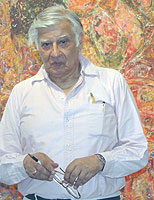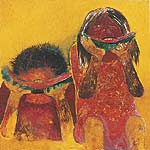
16th Aug 2005
The conceptual
rigour with
which Khanna
approaches
his subjects
has not
diminished
and neither
has the artist's
unease for them.
 AT 80, having just entered his octogenarian years Krishen Khanna is a magisterial presence whose works are not
monologues seeking out a listener, they
are instead eager to conduct a dialogue
with the viewer.
AT 80, having just entered his octogenarian years Krishen Khanna is a magisterial presence whose works are not
monologues seeking out a listener, they
are instead eager to conduct a dialogue
with the viewer.
"The only ism the Progressive Artists' Group
had in common was their individualism," art critic
Rudi Von Leyden had once remarked about the
Progressive Artists' Group (PAG). Though Khanna
joined the PAG just before they disbanded, he, in
keeping with the explicit ethos of the group looked
beyond the heavily perpetuated nationalism and in
the direction of modernism and the vicissitudes
that wrought it.
In a trajectory vaguely similar to that of the
Post-impressionist Paul Gauguin, who before he
realised his genius for the vibrancy of colours
made a career out of trading at the stock exchange,
Krishen Khanna when he first arrived in post-partition Mumbai occupied himself with a staid banking job in the city.
Having made his formal debut as an artist with
the painting News of Gandhi's Death (1948), that
had people standing around a traffic island in
Delhi, reading newspapers, Khanna in the decades
to come refused to let the initial humanism of his
works fade away Though Khanna's present practice
does not claim to be
ensconced in the volatility of
experimentation the artist
has in the past undertaken
parallel journeys that have led
him to photography and
murals.
The 34 canvases and a
selection of small format
works showcased at the ongoing exhibit are a return to the
looming anxieties that have
plagued the artist's scruples.
Khanna's pictorial inquiries,
within the scope of their modernist proclivities, constantly incorporate icons of his
immediate milieu. So the wailing blue of the saree
that Mary has draped around her eagerly corroborates the effect of the Pieta (2004).
The conceptual rigour with which Khanna
approaches his subjects has not diminished and
neither has the artist's unease for them Using his
repeated concern for one of his most prominent
subjects the bandwallas as a peg Khanna explains,
"The early bandwallas comprised of free flowing
brush work. In the years since my treatment of
space and subject has been consciously refined."
 In September 1989 Jagdish Swaminathan had
commented thus on Khanna's bandwalllas,
"Shabbily costumed when accompanying middle-
class marriage processions in the cities, the band is
a macabre comment on bourgeois existence." It
would be worthwhile to recall here that Jagdish
Swaminathan had launched scalding attacks against
the PAG with his manifesto that was critical of art
that did not follow closely the dictates of abstraction
and / or minimalism.
In September 1989 Jagdish Swaminathan had
commented thus on Khanna's bandwalllas,
"Shabbily costumed when accompanying middle-
class marriage processions in the cities, the band is
a macabre comment on bourgeois existence." It
would be worthwhile to recall here that Jagdish
Swaminathan had launched scalding attacks against
the PAG with his manifesto that was critical of art
that did not follow closely the dictates of abstraction
and / or minimalism.
Continuing from
where Swaminathan left
off one could propose
that with the bandwallas,
Khanna succeeds in commenting on both the proletarian and the bourgeois condition.
Juxtaposed alongside a
wedding procession the bandwallas are not a
comment on the 'bourgeois existence' alone but
also on the proletarian
situation. Despite the
heading of Bandwalla. in
Frenzy (2004) one finds a lucid reflection of
Khanna's quote on the 'refinement of space and
subject' in the painting. In the works at the present
exhibition there is a greater effort in the direction
of delineation.
This delineation does not suggest that the figures are overdetermined. On the contrary in works
such as Nazar Husain's Tea (2004) it appears as
though the steam rising from the kettle has
obscured the kettle, which in more ways than one is
the object of focus. In another work Doubting
Thomas and Christ (2004) a similar obscuration is
found. The laceration on the body of Christ that
doubting Thomas is reaching out toward is covert.
With the present exhibition Khanna has
laboured at informing his repeated engagement
with the same themes, with the discipline of clarity
and renewed impulse that energise his art.
Read more articles